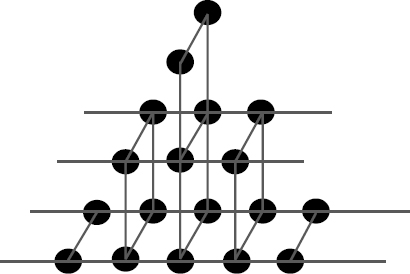17.3 HIERARCHICAL GRAPH NEURON
HGN is composed of layers of GN networks arranged in a pyramid-like composition. The base layer corresponds to the size of the pattern to be used in the pattern-recognition application. The size of the pattern is equal to the number of elements in the pattern. Each element may be assigned a fixed number of possible values from the pattern domain. For instance, a black and white bitmap representation would have two possible values, that is, ‘1’ or ‘0’, for every pixel position. The HGN compositions for pattern size 5 with two possible values and pattern size 7 with three possible values are shown in Figures 17.3 and 17.4, respectively.

Figure 17.3 HGN Architecture for pattern size 5 and two possible values.
HGN algorithm is similar to the simple GN algorithm, with the exception of the hierarchical structure. The benefit of having this structure is that the top GN nodes are able to provide oversight for the base layer, and thus eliminate the cross-talk. Each layer of the HGN acts as a simple GN network with the difference that the higher layers (all layers except the base layer) would store the pair values as p(index_left, index_middle, index_right). Where index_left, index_middle, index_right represent the inputs received from the left, bottom, and right GNs respectively. Each of these indices represents the row number in the bias arrays corresponding ...
Get Mobile Intelligence now with the O’Reilly learning platform.
O’Reilly members experience books, live events, courses curated by job role, and more from O’Reilly and nearly 200 top publishers.

